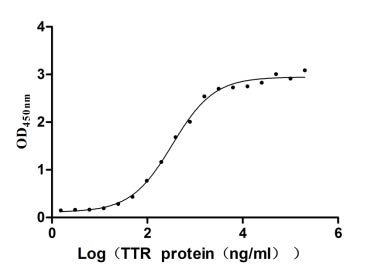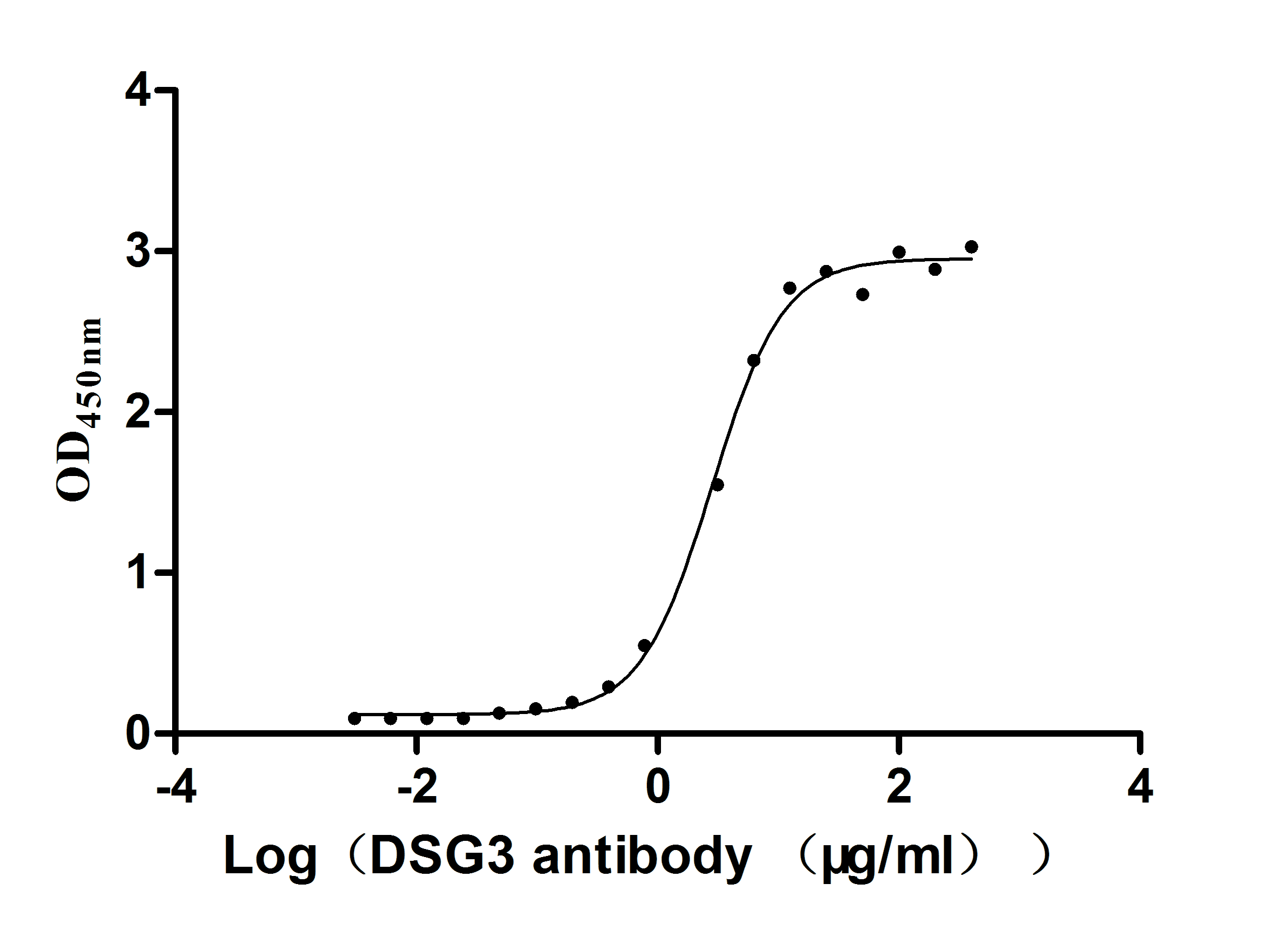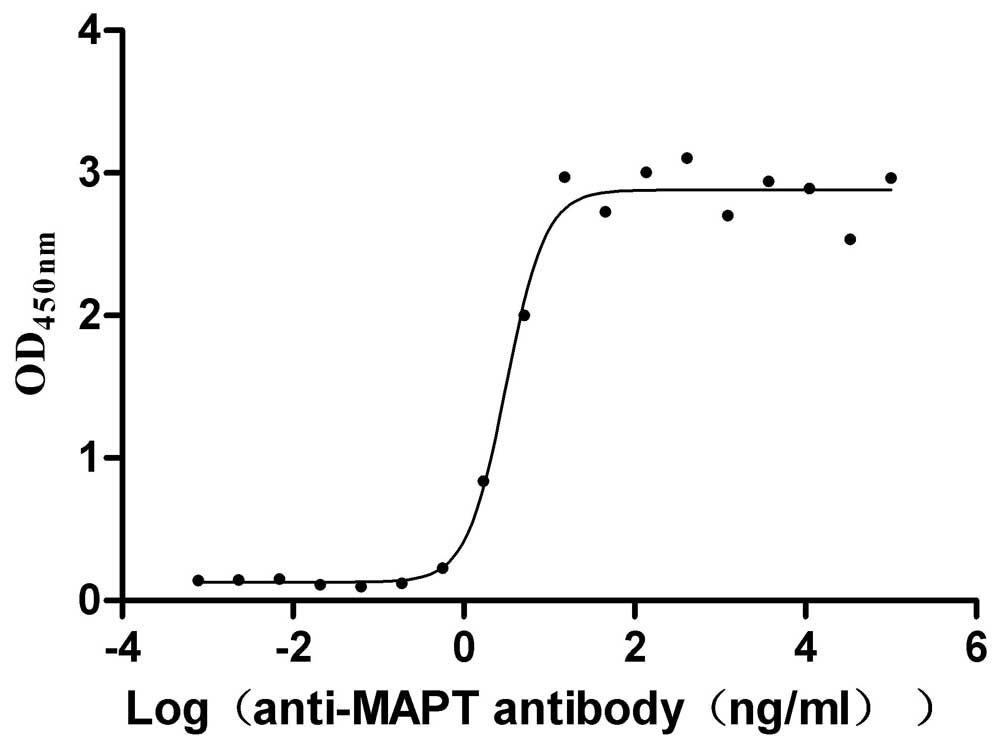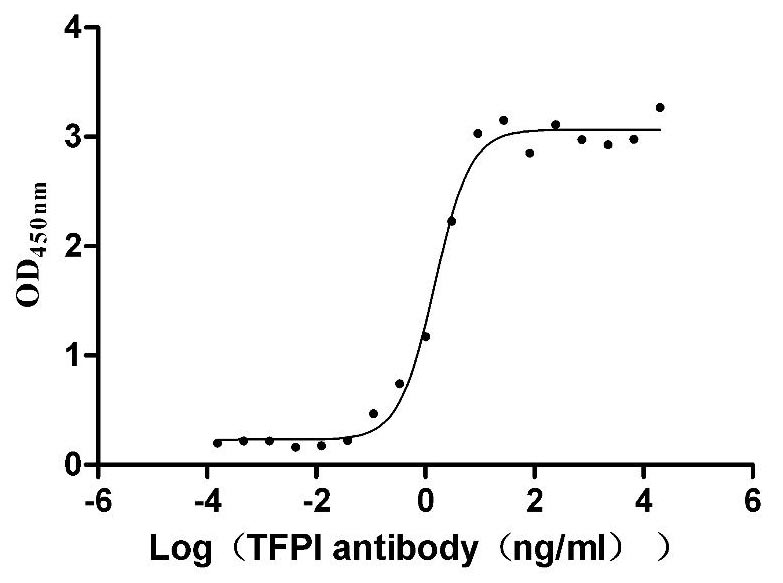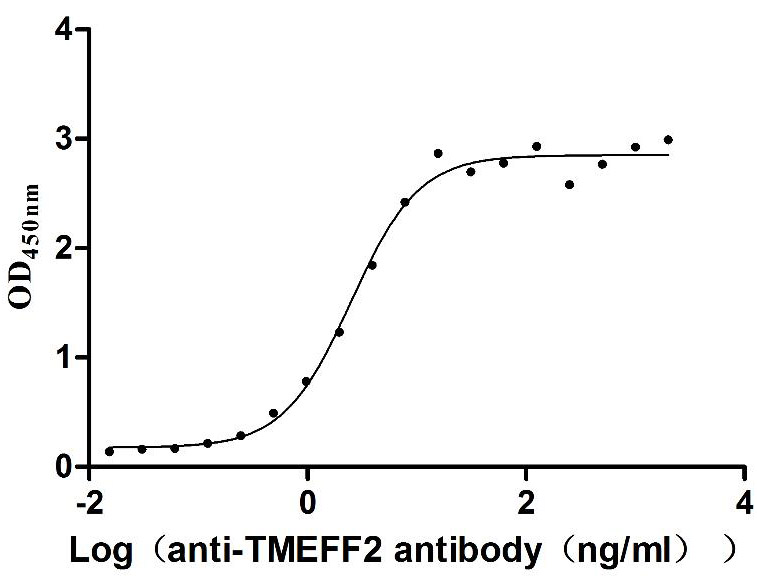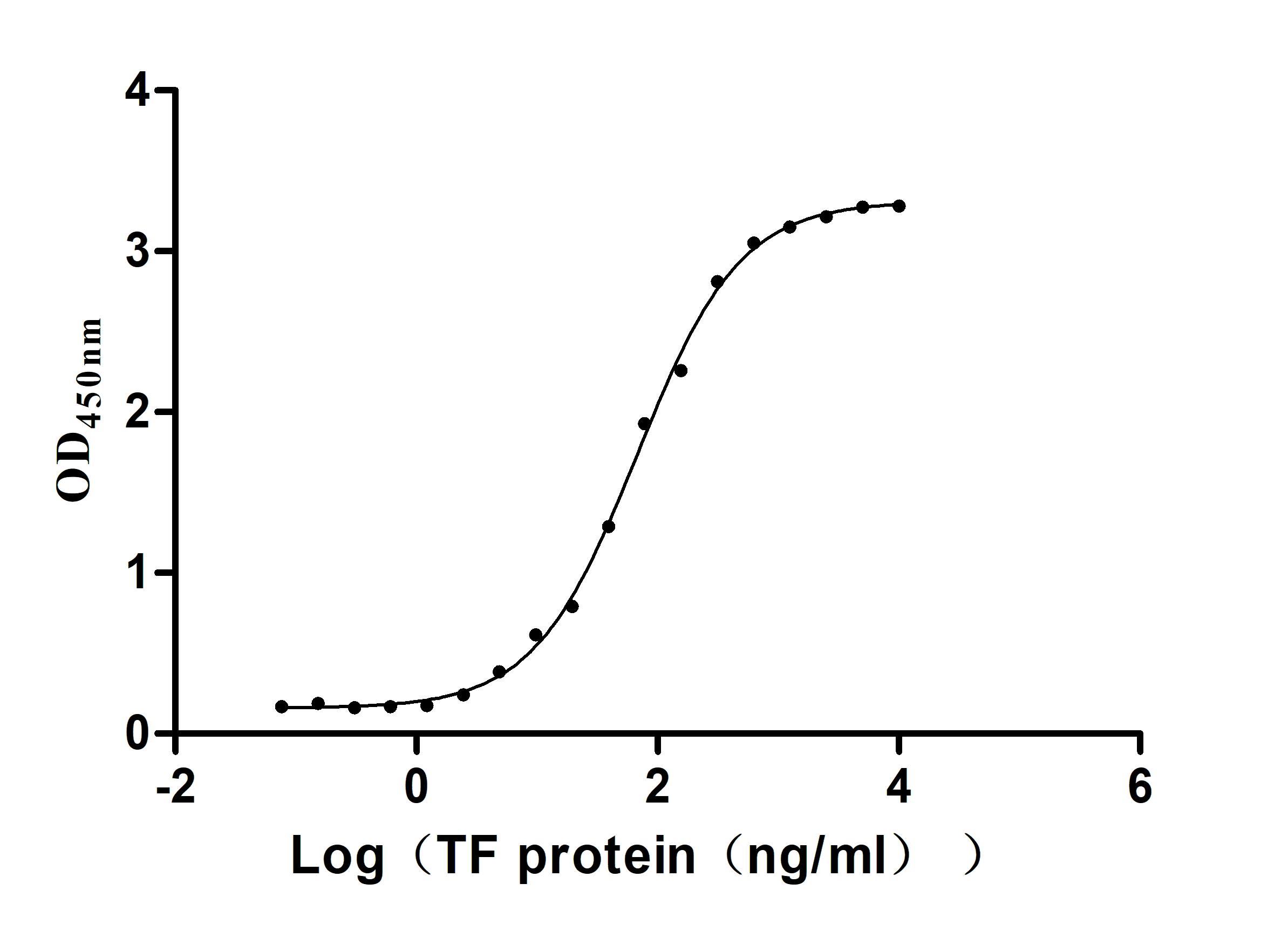Recombinant Human Secretogranin-2 (SCG2)
-
中文名稱:人SCG2重組蛋白
-
貨號:CSB-EP020808HU-B
-
說明書:
-
規格:
-
來源:E.coli
-
共軛:Avi-tag Biotinylated
E. coli biotin ligase (BirA) is highly specific in covalently attaching biotin to the 15 amino acid AviTag peptide. This recombinant protein was biotinylated in vivo by AviTag-BirA technology, which method is BriA catalyzes amide linkage between the biotin and the specific lysine of the AviTag.
-
其他:
產品詳情
-
純度:>85% (SDS-PAGE)
-
基因名:SCG2
-
Uniprot No.:
-
別名:CHGC; Chromogranin C; Chromogranin-C; EM66; SCG2; SCG2_HUMAN; Secretogranin II; Secretogranin-2; Secretoneurin; SGII; SN
-
種屬:Homo sapiens (Human)
-
蛋白長度:Full length protein
-
表達區域:31-617
-
氨基酸序列QRNQLLQKEP DLRLENVQKF PSPEMIRALE YIENLRQQAH KEESSPDYNP YQGVSVPLQQ KENGDESHLP ERDSLSEEDW MRIILEALRQ AENEPQSAPK ENKPYALNSE KNFPMDMSDD YETQQWPERK LKHMQFPPMY EENSRDNPFK RTNEIVEEQY TPQSLATLES VFQELGKLTG PNNQKRERMD EEQKLYTDDE DDIYKANNIA YEDVVGGEDW NPVEEKIESQ TQEEVRDSKE NIEKNEQIND EMKRSGQLGI QEEDLRKESK DQLSDDVSKV IAYLKRLVNA AGSGRLQNGQ NGERATRLFE KPLDSQSIYQ LIEISRNLQI PPEDLIEMLK TGEKPNGSVE PERELDLPVD LDDISEADLD HPDLFQNRML SKSGYPKTPG RAGTEALPDG LSVEDILNLL GMESAANQKT SYFPNPYNQE KVLPRLPYGA GRSRSNQLPK AAWIPHVENR QMAYENLNDK DQELGEYLAR MLVKYPEIIN SNQVKRVPGQ GSSEDDLQEE EQIEQAIKEH LNQGSSQETD KLAPVSKRFP VGPPKNDDTP NRQYWDEDLL MKVLEYLNQE KAEKGREHIA KRAMENM
-
蛋白標簽:Tag?type?will?be?determined?during?the?manufacturing?process.
The tag type will be determined during production process. If you have specified tag type, please tell us and we will develop the specified tag preferentially. -
產品提供形式:Lyophilized powder Warning: in_array() expects parameter 2 to be array, null given in /www/web/cusabio_cn/public_html/caches/caches_template/default/content/show_product_protein.php on line 662
Note: We will preferentially ship the format that we have in stock, however, if you have any special requirement for the format, please remark your requirement when placing the order, we will prepare according to your demand. -
復溶:We recommend that this vial be briefly centrifuged prior to opening to bring the contents to the bottom. Please reconstitute protein in deionized sterile water to a concentration of 0.1-1.0 mg/mL.We recommend to add 5-50% of glycerol (final concentration) and aliquot for long-term storage at -20℃/-80℃. Our default final concentration of glycerol is 50%. Customers could use it as reference.
-
儲存條件:Store at -20°C/-80°C upon receipt, aliquoting is necessary for mutiple use. Avoid repeated freeze-thaw cycles.
-
保質期:The shelf life is related to many factors, storage state, buffer ingredients, storage temperature and the stability of the protein itself.
Generally, the shelf life of liquid form is 6 months at -20°C/-80°C. The shelf life of lyophilized form is 12 months at -20°C/-80°C. -
貨期:Delivery time may differ from different purchasing way or location, please kindly consult your local distributors for specific delivery time.Note: All of our proteins are default shipped with normal blue ice packs, if you request to ship with dry ice, please communicate with us in advance and extra fees will be charged.
-
注意事項:Repeated freezing and thawing is not recommended. Store working aliquots at 4°C for up to one week.
-
Datasheet :Please contact us to get it.
相關產品
靶點詳情
-
功能:Neuroendocrine protein of the granin family that regulates the biogenesis of secretory granules.
-
基因功能參考文獻:
- Differential Reovirus-Specific and Herpesvirus-Specific Activator Protein 1 Activation of Secretogranin II Leads to Altered Virus Secretion. PMID: 26378181
- present data show that SgII is highly expressed in advanced prostate cancer and may contribute to the neuroendocrine differentiation by promoting the formation of secretory granules and the proliferation of PCa cells. PMID: 25307750
- SN induces MUC5AC hypersecretion in a dose- and time-dependent manner; moreover, the MUC5AC over synthesis induced by SN is strongly associated with the enhanced binding of EGF to NRP1 PMID: 24556756
- Topical secretoneurin gene therapy accelerates diabetic wound healing by interaction between heparan-sulfate proteoglycans and basic FGF. PMID: 23918206
- Manserin may serve as a marker of prostate cancer progression. PMID: 21803620
- CgA, CgB, and secretoneurin are detectable in feces, and collagenous colitis patients express higher values than patients with inflammatory bowel disease and controls. In treatment, fecal secretoneurin decreased to control levels in collagenous colitis. PMID: 23423580
- In vivo secretoneurin improves left ventricular function, inhibits remodeling, and reduces scar formation; in the infarct border zone, secretoneurin induces coronary angiogenesis. PMID: 23081990
- Circulating Levels of SgII are Increased in Patients with chronic, stable heart failure. PMID: 22655045
- Data describe the gene expression and protein production of SgII in normal adrenal glands and pheochromocytomas with the goal to examine the molecular mechanisms leading to the marked variations in the expression of EM66 in tumoral chromaffin tissue. PMID: 22217803
- This short review deals with investigations in neuroendocrine tumors (NETs) with antibodies against defined epitopes of chromogranins (Cgs) A and B and secretogranins (Sgs) II and III. PMID: 21046454
- More SgII immunoreactive cells were observed in phaeochromocytomas. PMID: 20550951
- Transendothelial migration of leukocytes and signalling mechanisms in response to the neuropeptide secretoneurin. PMID: 11853870
- secretogranin II-derived peptide EM66 generated in human tumoral chromaffin tissue; significant difference in EM66 concentrations between benign and malignant pheochromocytomas PMID: 12788858
- the high concentration of secretoneurin in the aqueous humor indicates a significant role of this peptide PMID: 15572199
- a variant of Secretogranin II has a role in regulation by PHOX2 transcription factors and in hypertension PMID: 17584765
- Results suggest that secretogranin II represents a key AP-1-regulated protein that counteracts nitric oxide toxicity and mediates neuronal differentiation of neuroblastoma cells. PMID: 18239671
- Increased concentrations of SgII, especially the N-terminal part of secretoneurin could be measured in plasma from patients with endocrine pancreatic tumours. PMID: 18448176
- Suppression of Pdcd4 resulted in an increased release of CgA and Sg II and was accompanied by an up-regulation of intracellular PC1. PMID: 18549351
- semiquantitative immunocytochemistry for secretogranin II in amyotrophic lateral sclerosis. PMID: 18721831
顯示更多
收起更多
-
亞細胞定位:Secreted. Note=Neuroendocrine and endocrine secretory granules.
-
蛋白家族:Chromogranin/secretogranin protein family
-
數據庫鏈接:
Most popular with customers
-
Recombinant Human Transthyretin (TTR) (Active)
Express system: Mammalian cell
Species: Homo sapiens (Human)
-
Recombinant Mouse Desmoglein-3 (Dsg3), partial (Active)
Express system: Mammalian cell
Species: Mus musculus (Mouse)
-
Recombinant Macaca mulatta Microtubule-associated protein tau (MAPT) (Active)
Express system: Mammalian cell
Species: Macaca mulatta (Rhesus macaque)
-
Recombinant Human Tissue factor pathway inhibitor (TFPI), partial (Active)
Express system: Mammalian cell
Species: Homo sapiens (Human)
-
Recombinant Human Claudin-4 (CLDN4)-VLPs (Active)
Express system: Mammalian cell
Species: Homo sapiens (Human)
-
Recombinant Human IL12B&IL12A Heterodimer Protein (Active)
Express system: Mammalian cell
Species: Homo sapiens (Human)
-
Recombinant Human Tomoregulin-2 (TMEFF2), partial (Active)
Express system: Mammalian cell
Species: Homo sapiens (Human)
-
Recombinant Human Serotransferrin(TF) (Active)
Express system: Mammalian cell
Species: Homo sapiens (Human)


